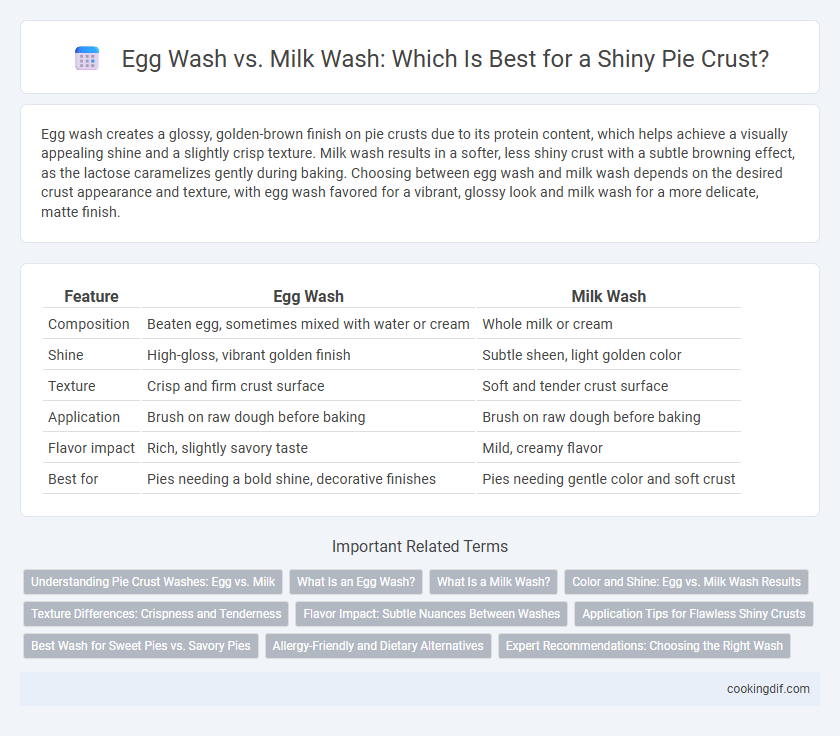Egg wash creates a glossy, golden-brown finish on pie crusts due to its protein content, which helps achieve a visually appealing shine and a slightly crisp texture. Milk wash results in a softer, less shiny crust with a subtle browning effect, as the lactose caramelizes gently during baking. Choosing between egg wash and milk wash depends on the desired crust appearance and texture, with egg wash favored for a vibrant, glossy look and milk wash for a more delicate, matte finish.
Table of Comparison
| Feature | Egg Wash | Milk Wash |
|---|---|---|
| Composition | Beaten egg, sometimes mixed with water or cream | Whole milk or cream |
| Shine | High-gloss, vibrant golden finish | Subtle sheen, light golden color |
| Texture | Crisp and firm crust surface | Soft and tender crust surface |
| Application | Brush on raw dough before baking | Brush on raw dough before baking |
| Flavor impact | Rich, slightly savory taste | Mild, creamy flavor |
| Best for | Pies needing a bold shine, decorative finishes | Pies needing gentle color and soft crust |
Understanding Pie Crust Washes: Egg vs. Milk
Egg wash creates a glossy, golden-brown finish on pie crusts due to its protein and fat content, which helps with browning and adds a rich shine. Milk wash produces a softer, matte sheen with subtle browning from the sugars, imparting a tender texture without the intense gloss. Choosing between egg and milk wash affects the crust's color, texture, and visual appeal, crucial for achieving the desired aesthetic and flavor in pies.
What Is an Egg Wash?
An egg wash is a mixture of beaten eggs, sometimes combined with water or milk, applied to pie crusts before baking to create a glossy, golden finish. The proteins and fats in the egg wash enhance browning and help the crust develop a crisp texture with an attractive shine. Compared to milk wash, egg wash provides a richer color and a more pronounced sheen, making it ideal for visually appealing pies.
What Is a Milk Wash?
A milk wash, made from whole milk or cream, is brushed onto pie crusts before baking to create a soft, golden-brown finish with a subtle sheen. Unlike egg wash, which provides a more intense shine and deeper color due to its protein and fat content, milk wash yields a gentler, less glossy appearance. This makes milk wash ideal for achieving a delicate crust texture while enhancing flavor with its natural sugars and fats.
Color and Shine: Egg vs. Milk Wash Results
Egg wash creates a deeper golden brown color and a glossy, reflective shine on pie crusts due to its protein and fat content. Milk wash yields a softer, muted color with a subtle sheen, as it contains less protein and fat compared to eggs. Choosing egg wash enhances both color vibrancy and crust shine, while milk wash offers a gentler, less intense finish.
Texture Differences: Crispness and Tenderness
Egg wash creates a glossy, golden crust with a crisp texture due to its protein content that coagulates and browns when baked. Milk wash, containing lactose and fat, promotes a softer, tender crust with a subtle sheen, enhancing moisture retention. Choosing between egg wash and milk wash depends on the desired balance of crispness and tenderness for the pie crust.
Flavor Impact: Subtle Nuances Between Washes
Egg wash enhances pie crust shine with a rich, savory flavor due to its protein and fat content, creating a golden, slightly crispy texture. Milk wash offers a gentler gloss with a mild, creamy taste that subtly sweetens the crust without overpowering the filling. Choosing between egg and milk wash impacts not only appearance but also the flavor complexity of the pie crust.
Application Tips for Flawless Shiny Crusts
Egg wash creates a rich, golden shine and crisp texture on pie crusts, while milk wash provides a subtler, softer gloss and tender finish. For flawless results, brush egg wash gently in a thin, even layer before baking to avoid sogginess, and use cold milk wash applied sparingly for a delicate sheen without overpowering browning. Applying the wash just before placing the pie in the oven ensures maximum shine and prevents dripping or pooling that can compromise crust texture.
Best Wash for Sweet Pies vs. Savory Pies
Egg wash creates a glossy, deep golden crust, making it ideal for savory pies like chicken potpie or meat pies, where a rich sheen enhances the hearty filling. Milk wash yields a softer, more subtle shine with a slightly tender crust, perfect for sweet pies such as apple or berry pies, complementing their delicate sweetness without overpowering texture. For best results, use egg wash on savory pies to maximize color and finish, and milk wash on sweet pies to maintain a gentle, appealing appearance.
Allergy-Friendly and Dietary Alternatives
Egg wash and milk wash both enhance pie crust shine, but egg wash contains allergens like eggs, which can trigger reactions in sensitive individuals. Milk wash provides a dairy alternative but may cause issues for those with lactose intolerance or milk allergies. For allergy-friendly and dietary alternatives, options like aquafaba, coconut milk, or almond milk offer a shiny finish without common allergens.
Expert Recommendations: Choosing the Right Wash
Experts recommend egg wash for pie crust shine due to its ability to create a rich, golden-brown finish with a slightly glossy texture, enhancing both appearance and flavor. Milk wash offers a softer sheen and helps achieve a tender crust but lacks the intense color contrast of egg wash. Professional bakers often choose egg wash when a crisp, visually appealing crust is desired, while milk wash suits delicate pastries requiring subtle shine.
Egg wash vs milk wash for pie crust shine Infographic

 cookingdif.com
cookingdif.com